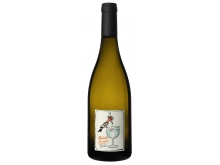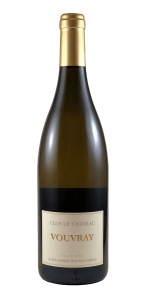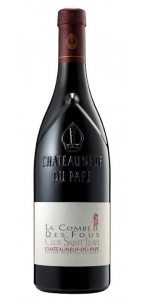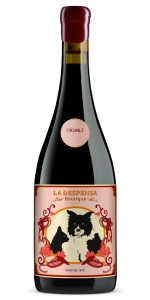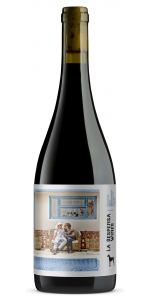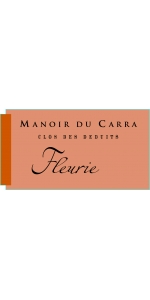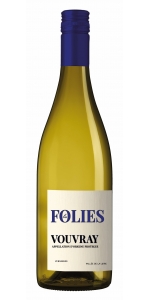Gaudrelle Clos de la Huppe Vouvray 2021
| Country: | France |
| Region: | Loire |
| Winery: | Gaudrelle |
| Grape Type: | Chenin Blanc |
| Organic: | Yes |
| Vintage: | 2021 |
| Bottle Size: | 750 ml |
Gaudrelle Monmousseau Clos le Vigneau Vouvray is made from 100% Chenin Blanc
Clos Le Vigneau is a single vineyard from an area known as "les Gués d'Amant" or "Lover's Gap". Most of the vines were planted in 1929.
Off dry in style with honey, earth and apricot notes. Wines from the town of Vouvray have been known to age well for 40 years. This particular bottling should hold for at least 5-7 years.
Clos Saint-Jean is a 41-hectare estate in Châteauneuf-du-Pape run by brothers Vincent and Pascal Maurel. Considered by many critics and wine-writers as the preeminent estate espousing the modern style of winemaking in Châteauneuf, this cellar is one of the oldest in the region, having been founded in 1900 by the greatgreat-grandfather of Vincent and Pascal, Edmund Tacussel. A short time after its founding and well before the AOP of Chateauneuf-du-Pape was created in 1923, Edmund began bottling estate wines in 1910.
The farming at Clos Saint-Jean is fully sustainable due to the warm and dry climate, which prevents the need for chemical inputs. Instead, Vincent and Pascal employ organic methods for pest control, mainly pheromones, to prevent pests from taking up residence in their vines, a process called amusingly enough in French, confusion sexuelle. The vines tended manually, and harvest is conducted in several passes entirely by hand.
Combe des Fous literally means, the hill of the fool. The hill, in this case, is located in the far southern reach of Le Crau which was left barren for many centuries because the layer of galets was so exceedingly deep that everyone assumed vines could never survive there. The fool in this situation is Edmund Tacussel, the great-great-grandfather of Vincent and Pascal Maruel who planted a Grenache vineyard on this site in 1905. That old-vine Grenache form the heart of this cuvée with a small amount of Syrah, Cinsault and Vaccarèse. La Combe des Fous is only made in the best vintages.
Review:
This has good concentration and energy to the dense core of dark fruit and bitter cherry, with great poise and elegance despite its ripeness (an impressive feat for the vintage). Guided by finely crushed mineral accents and tannins, this reveals pretty high-toned floral notes and leafy tobacco. Grenache, Syrah, Mourvedre, Cinsault, Vaccarese and Muscardin. Drink now through 2032. 900 cases made.
-Wine Spectator 95 Points
La Despensa Boutique Cinsault is made from 100% Cinsault.
A genuinely unique wine - they are the only producers of Cinsault in Colchagua! From a new vineyard planted in 2017, the team at La Despensa thinks they’ve hit the jackpot with this variety in this valley. Much more structure, color and intensity than the typical Chilean Cinsaults from further south, this is an easy drinking but serious version of this wonderfully fruity variety!
Review:
"Apparently the first and only Cinsault from Colchagua, the 2021 Boutique Cinsault was produced with vines planted in 2017 and worked organically (but is not certified), and it's much darker and more structured than the examples from the south. It fermented in concrete with selected yeasts and went through malolactic in stainless steel and then 60% of the volume matured in used barriques for six months. It has 13.5% alcohol and kept good freshness, and it's varietal, balanced and easy to drink but not banal. 1,200 bottles were filled in March 2022. - Luis Gutiérrez"
- Robert Parker's Wine Advocate (April 2023), 91 pts
La Despensa Boutique Pool Blend 75% Cinsault, 15% Pais, 5% Marsanne and 5% Roussanne.
A genuinely unique wine - La Despensa is the only producer of Cinsault in Colchagua and Pais from this valley is also extremely rare! The Cinsault and the 2 whites come from a new vineyard planted in 2017 and the Pais from a 150 year old, dry-farmed vineyard in Pumanque about 20 minutes from the winery that they run themselves organically. The Cinsault and Pais give notes of raspberry and strawberry and the white Roussanne and Marsanne a little mouthfeel and a hint of tropical fruit.
Organically grown grapes (not certified) from our own vineyard in Santa Ana, and Pumanque in the Colchagua Valley. Irrigated as sparingly as possible via drip irrigation (dry-farming for the 150 year old Pais). Hand harvested and sorted personally by me in the vineyard (I personally check every single bunch), then destemmed with the crusher removed from the destemmer. Grapes are fermented in open top bins and concrete tank and blended immediately after pressing. MLF occurs with the wine already blended. Wines are racked in November and again in January before being bottled after about 10 months ageing in 50% neutral oak barrels and 50% Flextank.
Versatile, goes well with beef, chicken, pasta, great for Summer BBQs
Review:
"The red blend 2021 Wines Pool Blend was produced with an unusual blend, especially for a wine from Colchagua, of 75% Cinsault, 15% País and 5% each Marsanne and Roussanne. It has kept a moderate 13.5% alcohol and retained good freshness (pH 3.44) after maturing exclusively in Flextank and being bottled unoaked. This is fruit-driven and straightforward, with a medium-bodied palate and fine tannins. 2,400 bottles produced. It was bottled in March 2022. - Luis Gutiérrez"
- Robert Parker's Wine Advocate (April 2023), 90 pts
Manoir du Carra Beaujolais Cru Fleurie Clos des Deduits is made from 100% Gamay grapes coming from the lieu dit "Montee de la Tonne".
The vineyard measures 1.5 hectare and the average age of the vines is 50 years. Yield: 48 hl/ha
Manual harvest; Semi-carbonic maceration for 10-12 days; Aging in Foudre for 3-4 months; Slight filtration.
Intense red color, subtle fruity and floral aromas of violet, berry and cinnamon. Ample in the mouth, fruit flavors. Even better after a few years of cellaring.
Excellent with red and game meats, and cheeses.
Alain de la Treille Les Folies Vouvray is made from 100 percent Chenin Blanc.
This is our newest Loire valley project, with an Eco friendly lightweight bottle and a screwcap.
Les Folies Vouvray is stunning with its elegancy and freshness which is carried through the ripe fruity palate, manned with hints of honey and apricots.
Les Folies Vouvray goes well with Asian food, fishes, charcuteries, BBQ pork spareribs or simply as an aperitif.
Gaudrelle Clos de la Huppe Vouvray is made from 100% Chenin Blanc.
Gaudrelle Vouvray Clos de la Huppe is coming from a very specific vineyard called "Clos de la Huppe".
all the plowing and the work in the vineyard is done by hand with the help of a horse.
This wine is named after the Eurasian hoopoe, a bird species that enjoys our vineyards again since we got into more natural farming. Draft horse, manual harvesting, fermentation with indigenous yeasts and an 18-month aging on the lees make for a characterful and mineral wine.
The Gaudrelle Estate
Chateau Gaudrelle is owned by fifth generation winemaker Alexandre Monmousseau. Alexandre's father, Armand Monmousseau, is the former head of his family's sparkling wine firm in Montrichard. Alexandre, intense and confident, received his schooling in Beaune and is one of the leaders of the Sec-Tendre (soft-dry) movement that includes producers like Huet and Champalou..
Monmousseau also produces Kysela's famous Vouvray, Clos le Vigneau.
The AOC of Vouvray covers 9 villages:
• Vouvray
• Vernou sur Brenne
• Noizay
• Chançay
• Reugny
• Parçay
• Meslay
• Rochecorbon
• Tours-Sainte Radegonde, which is the birth place of the vineyard (end of the 4th century).
"It is amazing how good a value Vouvray has remained despite the fact that it is such a popular wine from Loire. The appellation was founded in 1936 and covers nine villages in the region. You can find sparkling wines at this estate – sec (dry) or demi-sec (basically off-dry, although for most consumers these would be considered dry) – as well as their sweet wines, which vary considerably in their degrees of sweetness and are referred to as moelleux. All four of the following cuvees performed brilliantly in my tasting." - Robert Parker's Wine Advocate (June 2012)
The Gaudrelle Vineyard
Today the Monmousseau family farms 14 hectares (34.6 acres) of land: 6 hectares for Clos le Vigneau, 8 hectares for Château Gaudrelle. Clos Le Vigneau is a single vineyard from an area known as “les Gués d'Amant” or “Lover’s Gap”. Most of the vines were planted in 1929. The soil is a mixture of argilo-calcaire, silex and gravel. Alexandre Monmousseau believes in low yields for concentration and flavor. The grapes are hand harvested. Pressing is long and slow, fermentation is in stainless steel with two rackings and a light filtration before bottling.
- back
Maggy Hawk Unforgettable Pinot Noir is made from 100 percent Pinot Noir.
HARVEST NOTES
All plants require water to grow, and grapevines are no exception. The 2021 growing season was our driest yet. The Maggy Hawk vineyard relies on rainfall in the winter and spring to fill our vineyard ponds to irrigate our vines during the summer months. These ponds ran dry a few weeks before harvest began. Fortunately, the grapes made it across the finish line without being affected by the drought. We typically harvest over 2-3 weeks. In 2021, everything was ready at once, and we harvested in just one and a half weeks. The clusters had a shorter ripening period and were harvested on the earlier side, which produced wines with intense hues, great acidity, and concentrated aromas and flavors.
WINEMAKING
Our 2021 Unforgettable Pinot Noir is crafted from a unique selection of five blocks and three clones from all corners of the Maggy Hawk vineyard. Upon arriving at the winery, we separate the individual blocks and allow the grapes to cold soak for 5 days before raising the temperature and beginning fermentation. The fruit is then pressed very gently, and the free run is kept separate from the harder pressing and racked down to barrels. The wine is allowed to go through malolactic fermentation on its own before being left to age in 30% new French oak barrels for 17 months. Finished unfined and unfitered.
Freshness, power and persistence. Unforgettable delivers a pronounced mix of fresh black cherry and red plum balanced by hints of dried lavender, bay leaf, anise and potting soil notes. A perfect balance of structured and juicy with smooth, rounded edges on the palate due to integrated tannin.
Review:
This wine is opulent, with aromas of Black cherry, red currant compote, cinnamon spice, and fresh florals on the nose. The flavors on the palate are Bing cherry, blackcurrant confiture, vanilla lime cream interwoven with dried herbs, bittersweet chocolate, earth and a long silky finish. Hold or Drink until 2032 Pair with Lamb Shoulder — Tonya Pitts
-Wine Enthusiast 94 Points
The 2021 Pinot Noir Unforgettable boasts a deeper red/ruby color and was aged in 38% new French oak. There’s more 667 clone in this blend, which reveals a darker profile in the glass, with red and black-fruited notes of black raspberries, brambly herbs, forest floor, and cedar. Medium-bodied, it has a broader shouldered feel, with lovely structure throughout and a lovely, ripe finish. It’s going to drink well over the coming 10 years.
-Jeb Dunnuck 94 Points
Holocene Sidereal Pinot Noir is made from 100 percent Pinot Noir.
Single Vineyard dry-farmed, Organic practices
100% whole cluster
Fermented with native yeast
Extended maceration, with gentle extraction techniques
14 months in 20% new French oak
Bottled unfined and unfiltered with minimal SO2
The word sidereal means relating to the stars, particularly when measuring time or astronomical events. Which is weird for an earthly delight of a wine that makes time stand still while you attempt to decipher a vast array of aromas ranging from blackcap raspberries and cherry blossoms to wet slate and moon dust. Blackberries rule on the palate, with Assam tea, bay leaf and black pepper flavors easing along a lithe and nimble mouthfeel. Sidereal is also balance personified

